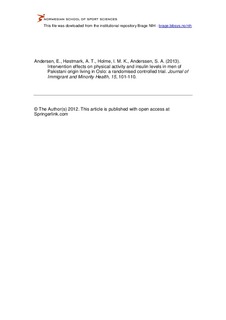| dc.contributor.author | Andersen, Eivind | |
| dc.contributor.author | Høstmark, Arne Torbjørn | |
| dc.contributor.author | Holme, Ingar Morten K. | |
| dc.contributor.author | Anderssen, Sigmund A. | |
| dc.date.accessioned | 2013-02-13T13:01:20Z | |
| dc.date.available | 2013-02-13T13:01:20Z | |
| dc.date.issued | 2012-07-25 | |
| dc.identifier | Seksjon for idrettsmedisinske fag / Department of Sports Medicine | |
| dc.identifier.citation | Journal of Immigrant and Minority Health. 2013, 15, 101-110 | no_NO |
| dc.identifier.uri | http://hdl.handle.net/11250/170966 | |
| dc.description | © The Author(s) 2012. This article is published with open access at Springerlink.com | no_NO |
| dc.description.abstract | High prevalence of type 2 diabetes (T2D) is seen in some immigrant groups in Western countries, particularly in those from the Indian subcontinent. Our aims were to increase the physical activity (PA) level in a group of Pakistani immigrant men, and to see whether any increase was associated with reduced serum glucose and insulin concentrations. The intervention was developed in collaboration with the Pakistani community. It used a social cognitive theory framework and consisted of structured supervised group exercises, group lectures, individual counselling and telephone follow-up. One- hundred and fifty physically inactive Pakistani immigrant men living in Oslo, Norway, were randomised to either a control group or an intervention group. The 5-month intervention focused on increasing levels of PA, which were assessed by use of accelerometer (Actigraph MTI 7164) recordings. Risk of diabetes was assessed by serum glucose and insulin concentrations determined in a fasted state, and after an oral glucose tolerance test (OGTT). ANCOVA was used to assess differences between groups. There was a mean difference in PA between the two groups of 49 counts per minute per day, representing a 15 % (95 % CI = 8.7–21.2; P = 0.01) higher increase in total PA level in the intervention group than in the control group. Insulin values taken 2 h after an OGTT were reduced in the intervention group by 27 % (95 % CI = 18.9–35.0; P = 0.02) more than those in the control group. There were no differences in fasting or postprandial glucose values between the groups at the follow-up test. This type of intervention can increase PA and reduce serum insulin in Pakistani immigrant men, thereby presumably reducing their risk of T2D. | no_NO |
| dc.language.iso | eng | no_NO |
| dc.publisher | Springer Verlag | no_NO |
| dc.subject | minority group | no_NO |
| dc.subject | glucose | no_NO |
| dc.subject | insulin | no_NO |
| dc.subject | physical activity | no_NO |
| dc.title | Intervention effects on physical activity and insulin levels in men of Pakistani origin living in Oslo: a randomised controlled trial | no_NO |
| dc.type | Journal article | no_NO |
| dc.type | Peer reviewed | no_NO |
| dc.subject.nsi | VDP::Medical disciplines: 700 | no_NO |
| dc.subject.nsi | VDP::Medical disciplines: 700::Health sciences: 800 | no_NO |
| dc.source.pagenumber | 101-110 | no_NO |
| dc.source.volume | 15 | no_NO |
| dc.source.journal | Journal of Immigrant and Minority Health | no_NO |
| dc.source.issue | 1 | no_NO |
| dc.identifier.doi | 10.1007/s10903-012-9686-3 | |
